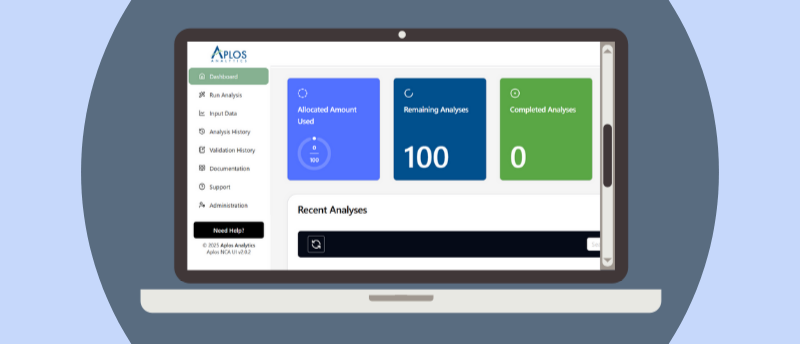Nathan Teuscher on how Aplos Analytics is transforming the PK analysis landscape

In this interview, Nathan Teuscher, Founder and President of Aplos Analytics, Inc. (UT, USA), relays his vision for building Aplos — to modernize and streamline pharmacokinetic (PK) analysis.
Meet the interviewee:

Nathan Teuscher
Founder and & President
Aplos Analytics
Nathan Teuscher is the Founder and President of Aplos Analytics, Inc. He also hosts the Clinical Pharmacology Podcast, where he shares his expertise in clinical pharmacology, pharmacokinetics, and pharmacometrics with a global audience. Nathan holds a BS in Biochemistry from Brigham Young University (UT, USA) and an MS and PhD in Pharmaceutical Sciences from the University of Michigan, where he studied under David E. Smith. Throughout his career, he has gained extensive experience in drug metabolism, non-clinical development, pharmacokinetics, clinical pharmacology, pharmacometrics, and software development, working with biotechnology, pharmaceutical, and consulting firms.
In 2023, Nathan founded Aplos Analytics, Inc. to create innovative software solutions for data analysis aimed at pharmaceutical scientists. His goal is to streamline the data analysis process and enhance decision-making in drug development. Nathan resides in Pleasant Grove, Utah, with his wife and has two married children.
- What inspired you to establish Aplos Analytics, and how did your background in clinical pharmacology shape the company’s mission?
- Can you explain the differences between compartmental and non-compartmental approaches in PK analysis?
- Traditional NCA methods have been time-consuming and human error–prone. How does Aplos NCA address these challenges?
- Do you have any tips on ensuring NCA results are accurate and reproducible, especially when dealing with variable data such as those from different patient populations or animal models?
- With the increasing importance of data security, how does Aplos ensure the protection of sensitive PK data?
- Looking ahead, what emerging trends do you foresee in PK analysis?
What inspired you to establish Aplos Analytics, and how did your background in clinical pharmacology shape the company’s mission?
I’ve always been passionate about helping people understand scientific topics. After earning degrees in pharmaceutical sciences, specializing in pharmacokinetics from the University of Michigan (USA), I spent the past 25 years helping others make sense of these complex principles. I founded Aplos Analytics to modernize and streamline PK analysis. The name Aplos, derived from Greek, means “simple” or “to simplify,” which captures the essence of what we aim to do.
Over time, I became increasingly frustrated with how inefficient and error-prone existing PK workflows were, especially for non-compartmental analysis. The science hasn’t changed in decades, but the tools were still slow, manual and required specialized training. I wanted something fast, accurate, easy to use and automatable. When I searched for such a solution, nothing met those criteria, so I decided to build it. Today, Aplos NCA is the only cloud-based API that calculates pharmacokinetic parameters using non-compartmental methods. It requires no coding skills, no desktop installation and minimal training, delivering validated PK results in under 35 seconds with full transparency and reproducibility.
Can you explain the differences between compartmental and non-compartmental approaches in PK analysis?
Compartmental and non-compartmental analysis (NCA) are two fundamental approaches used to analyse PK data, but they differ in methodology and assumptions.
NCA is a model-independent method that estimates PK parameters directly from observed data, without assuming a specific physiological model. It uses statistical techniques like the trapezoidal rule and log-linear regression to calculate metrics such as clearance, half-life and AUC — the extent of exposure of a drug.
Compartmental analysis, by contrast, uses mathematical models to represent drug distribution and elimination across compartments in the body. It fits differential equations to the data, allowing for simulation and prediction, but requires more assumptions. NCA is simpler, faster and widely used in early-phase studies, while compartmental modelling provides deeper mechanistic insights when needed.
Traditional NCA methods have been time-consuming and human error-prone. How does Aplos NCA address these challenges?
Aplos NCA was built for automation using secure, cloud-based technology. A single analyst can submit multiple analyses and receive full reports within minutes. The system automatically selects terminal slopes, generates summary tables and plots, and requires no manual input. This entire process can be integrated into existing workflows through a fully functional API, eliminating human error and dramatically accelerating turnaround times.
You may also be interested in:
- Transforming PK Analysis With the Aplos Analytics NCA Platform
- Ask the Experts: organization and transformation of bioanalytical data for PK analysis
- Pharmacokinetics and toxicity considerations for antibody–drug conjugates: an overview
Do you have any tips on ensuring NCA results are accurate and reproducible, especially when dealing with variable data such as those from different patient populations or animal models?
Accurate NCA results start with clean, well-prepared data. Aplos NCA supports this by offering tools for data manipulation, including unit conversions and field creation, directly within the platform. All analyses are run based on structured text instruction files, which are returned with each output, ensuring complete reproducibility and traceability for both internal review and regulatory submissions.
With the increasing importance of data security, how does Aplos ensure the protection of sensitive PK data?
Aplos uses enterprise-grade security protocols to protect sensitive data. All information is encrypted, version-controlled and stored in systems that prevent unauthorized access or modification. We provide full audit trails for every file and analysis, as well as automated backups and protections against malware or ransomware. Access to data is restricted through expiring download links, ensuring only authorized users can retrieve results.
Looking ahead, what emerging trends do you foresee in PK analysis?
Pharma companies are under constant pressure to do more with fewer resources, and automation is becoming key to addressing that challenge. We’re seeing a strong shift toward real-time and adaptive analysis, especially as decentralized trials gain traction. There’s also growing adoption of model-informed drug development, where PK/PD modelling supports faster and smarter decisions throughout development. Finally, seamless API integration and machine-readable outputs will become standard, allowing PK tools to connect directly with data lakes, regulatory systems and even AI pipelines. The future of PK analysis is fast, scalable and deeply embedded in digital workflows.
Enjoy this interview? View our entire collection here.
The opinions expressed in this interview are those of the interviewee and do not necessarily reflect the views of Bioanalysis Zone or Taylor & Francis Group.





